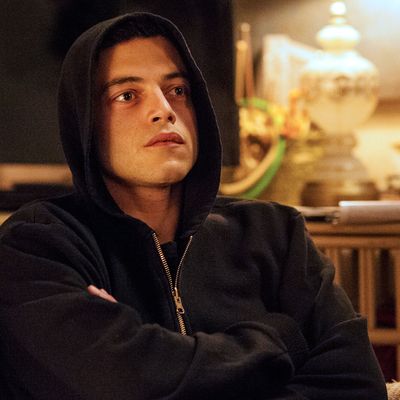
Mac Quayle has become the go-to musician for shows requiring an unconventional sound. Fresh off an Emmy nomination for his work on American Horror Story: Freak Show, Quayle scored the pilot episode of Ryan Murphy’s upcoming Scream Queens, and his electronics-laden work on the first season of Mr. Robot has drawn wide praise. Vulture spoke to Quayle about scoring the show’s excellent first season, from what’s influenced its sound to Elliot’s personal theme.
Show creator Sam Esmail and Quayle decided early on that the show’s soundtrack would be electronic.
“During our initial talks, we both agreed that it should be very electronic. That was going to be the sound, there would be no real instruments at all. And we’ve pretty much stayed with it. There is piano occasionally, a very processed piano sound, but the rest has stayed true to our original vision, which was totally electronic. That is my comfort zone.”
The child-pornography bust was one of the hardest to score.
“It was a challenging scene. I had to find the right tone, but I overshot the mark. I was so excited [about] the prospect of working on the show, but Sam wanted something a little more subtle, so he sent me back. I didn’t knock it out of the park, but he still wanted to hire me, though. Then I did five or six more revisions to get that scene right.”
Elliot’s hallucination sequence was one of the least challenging because Quayle could draw from his own experience.
“In my younger days, I certainly had some drug experiences to draw from. I was in an experimental-music band in NYC called Fiber, and for many years, that was our thing. We took drugs and then improvised with synthesizers and weird instruments. It felt kind of like coming home to work on that sequence. There wasn’t a specific experience I drew from, but just this general sense of being completely out of it. I was never that out of it, I never had any hallucination like Elliot had, but I certainly identified with the feeling. A lot of it was very unpleasant for Elliot, and when he wakes up in the bed crying, it was pretty intense, [what] he went through. I had some intense things as well.”
Brian Eno, Cliff Martinez, and the late ‘80s have been big influences on Mr. Robot’s musical style.
“I like to look back on some of the older 1980s stuff. Tangerine Dream [which appeared in the final scene of episode six], Brian Eno, Cabaret Voltaire. And then I spent many years working with Cliff Martinez, I did 12 films with him, and certainly, in recent years, a number of the scores went in an even more overtly electronic direction than before. He’s already had somewhat of an electronic sound, but Drive and Contagion were much more overtly electronic. I worked with him on those films and was certainly influenced by the direction he was taking, and even helping him to push his music a little farther down the pulsing-synthesizer road. Cliff is certainly a big influence.”
There are musical themes for certain characters.
“It was definitely an intention to do that. We didn’t feel like we had to adhere to a strict thematic approach, a classic film sorting approach, but we wanted to do it if we came up with some themes that worked. We could keep using and developing them for the particular characters. [For Elliot], I could say that I had a fancy thought process. I designed his theme based on theory and whatnot. It really just came out of me, and it’s very simple, so maybe it is more of a motif. But the one thing about it, it plays around with this major-minor idea. It will land on the major note, and then the minor note. To me, it says a little bit how Elliot, there is something really good in him, but then there is this huge darkness, and demons. I thought this simple technique of using the major note and the minor note would give us a little sense of both of those.”
Sam is very hands-on with everything, including the music.
“I haven’t had someone quite as passionate or hands-on with the music before. Ryan [Murphy] loves music as well, but he tends to be more of a yes or no person. He is a big-picture [person], he has a vision, and then it either matches his vision or doesn’t. Rather than lots of notes to change things, it’s either, ‘This is great,’ or, ‘We need something else from here.’”
“Sam and I finally clicked during episode five, which was by far the closest on the original draft than any of the previous ones. We have a language now, we can speak to each other. Sam doesn’t use technical musical terms. He talks more about colors and feelings, and he describes certain sounds he hears in the music that are or aren’t working for him. He may call this one particular sound something completely [different from] what it actually is, so I spent some time just getting to understand what he actually means. He’ll say, ‘I think it needs to get faster!’ when I think he really means he wants it to be more intense. There has definitely been a learning curve.”

